SN50v3-NB -- NB-IoT Sensor Node User Manual

Table of Contents:
- 1. Introduction
- 2. Use SN50v3-NB to communicate with IoT Server
- 3. Configure SN50v3-NB
- 4. Battery & Power Consumption
- 5. Firmware update
- 6. FAQ
- 7. Order Info
- 8. Packing Info
- 9. Support
1. Introduction
1.1 What is SN50v3-NB NB-IoT Sensor Node
SN50v3-NB is a Long Range NB-IoT Sensor Node. It is designed to facilitate developers to quickly deploy industrial level NB-IoT solutions. It helps users to turn the idea into a practical application and make the Internet of Things a reality. It is easy to program, create and connect your things everywhere.
SN50v3-NB wireless part is based on NB model allows the user to send data and reach extremely long ranges at low data-rates.It provides ultra-long range spread spectrum communication and high interference immunity whilst minimising current consumption.It targets professional wireless sensor network applications such as irrigation systems, smart metering, smart cities, smartphone detection, building automation, and so on.
SN50v3-NB uses STM32l0x chip from ST, STML0x is the ultra-low-power STM32L072xxxx microcontrollers incorporate the connectivity power of the universal serial bus (USB 2.0 crystal-less) with the high-performance ARM® Cortex®-M0+ 32-bit RISC core operating at a 32 MHz frequency, a memory protection unit (MPU), high-speed embedded memories (192 Kbytes of Flash program memory, 6 Kbytes of data EEPROM and 20 Kbytes of RAM) plus an extensive range of enhanced I/Os and peripherals.
SN50v3-NB is an open source product, it is based on the STM32Cube HAL drivers and lots of libraries can be found in ST site for rapid development.
SN50v3-NB supports different uplink methods including MQTT, MQTTs, UDP & TCP for different application requirement, and support uplinks to various IoT Servers.
SN50v3-NB supports BLE configure and OTA update which make user easy to use.
SN50v3-NB is powered by 8500mAh Li-SOCI2 battery, it is designed for long-term use up to severa years.
SN50v3-NB has optional built-in SIM card and default IoT server connection version. Which makes it works with simple configuration.

1.2 Features
- NB-IoT Bands: B1/B2/B3/B4/B5/B8/B12/B13/B17/B18/B19/B20/B25/B28/B66/B70/B85 @H-FDD
- Ultra-low power consumption
- Open-source hardware / software
- Multiply Sampling and one uplink
- Support Bluetooth v5.1 remote configure and update firmware
- Uplink via MQTT, MQTTs, TCP, or UDP
- Uplink on periodically
- Downlink to change configure
- 8500mAh Battery for long term use
- Nano SIM card slot for NB-IoT SIM
1.3 Specification
Common DC Characteristics:
- Supply Voltage: 2.5v ~ 3.6v
- Operating Temperature: -40 ~ 85°C
I/O Interface:
- Battery output (2.6v ~ 3.6v depends on battery)
- +5v controllable output
- 3 x Interrupt or Digital IN/OUT pins
- 3 x one-wire interfaces
- 1 x UART Interface
- 1 x I2C Interface
NB-IoT Spec:
NB-IoT Module: BC660K-GL
Support Bands:
- B1 @H-FDD: 2100MHz
- B2 @H-FDD: 1900MHz
- B3 @H-FDD: 1800MHz
- B4 @H-FDD: 2100MHz
- B5 @H-FDD: 860MHz
- B8 @H-FDD: 900MHz
- B12 @H-FDD: 720MHz
- B13 @H-FDD: 740MHz
- B17 @H-FDD: 730MHz
- B18 @H-FDD: 870MHz
- B19 @H-FDD: 870MHz
- B20 @H-FDD: 790MHz
- B25 @H-FDD: 1900MHz
- B28 @H-FDD: 750MHz
- B66 @H-FDD: 2000MHz
- B70 @H-FDD: 2000MHz
- B85 @H-FDD: 700MHz
Battery:
- Li/SOCI2 un-chargeable battery
- Capacity: 8500mAh
- Self Discharge: <1% / Year @ 25°C
- Max continuously current: 130mA
- Max boost current: 2A, 1 second
Power Consumption
- STOP Mode: 10uA @ 3.3v
- Max transmit power: 350mA@3.3v
1.4 Applications
- Smart Buildings & Home Automation
- Logistics and Supply Chain Management
- Smart Metering
- Smart Agriculture
- Smart Cities
- Smart Factory
1.5 Sleep mode and working mode
Deep Sleep Mode: Sensor doesn't have any LoRaWAN activate. This mode is used for storage and shipping to save battery life.
Working Mode: In this mode, Sensor will work as LoRaWAN Sensor to Join LoRaWAN network and send out sensor data to server. Between each sampling/tx/rx periodically, sensor will be in IDLE mode), in IDLE mode, sensor has the same power consumption as Deep Sleep mode.
1.6 Button & LEDs
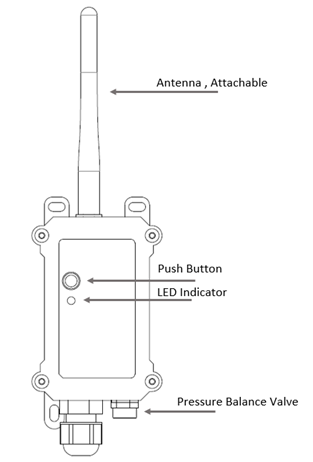
| Behavior on ACT | Function | Action |
|---|---|---|
| Pressing ACT between 1s < time < 3s | Send an uplink | If sensor has already attached to NB-IoT network, sensor will send an uplink packet, blue led will blink once. |
| Pressing ACT for more than 3s | Active Device | Green led will fast blink 5 times, device will enter OTA mode for 3 seconds. And then start to attach NB-IoT network. |
| Fast press ACT 5 times. | Deactivate Device | Red led will solid on for 5 seconds. Means device is in Deep Sleep Mode. |
1.7 BLE connection
SN50v3-NB support BLE remote configure and firmware update.
BLE can be used to configure the parameter of sensor or see the console output from sensor. BLE will be only activate on below case:
- Press button to send an uplink
- Press button to active device.
- Device Power on or reset.
If there is no activity connection on BLE in 60 seconds, sensor will shut down BLE module to enter low power mode.
1.8 Pin Definitions & Switch
SN50v3-NB use the mother board which as below.

1.8.1 Jumper JP2
Power on Device when put this jumper.
1.8.2 BOOT MODE / SW1
1) ISP: upgrade mode, device won't have any signal in this mode. but ready for upgrade firmware. LED won't work. Firmware won't run.
2) Flash: work mode, device starts to work and send out console output for further debug
1.8.3 Reset Button
Press to reboot the device.
2. Use SN50v3-NB to communicate with IoT Server
2.1 Send data to IoT server via NB-IoT network
The SN50v3-NB is equipped with a NB-IoT module, the pre-loaded firmware in SN50v3-NB will get environment data from sensors and send the value to local NB-IoT network via the NB-IoT module. The NB-IoT network will forward this value to IoT server via the protocol defined by SN50v3-NB.
Below shows the network structure:

There are two version: -GE and -1D version of SN50v3-NB.
GE Version: This version doesn't include SIM card or point to any IoT server. User needs to use AT Commands to configure below two steps to set SN50v3-NB send data to IoT server.
- Install NB-IoT SIM card and configure APN. See instruction of Attach Network.
- Set up sensor to point to IoT Server. See instruction of Configure to Connect Different Servers.
Below shows result of different server as a glance.
| Servers | Dash Board | Comments |
| Node-Red |
| |
| DataCake |
| |
| Tago.IO | ||
| General UDP | Raw Payload. Need Developer to design Dash Board | |
| General MQTT | Raw Payload. Need Developer to design Dash Board | |
| ThingSpeak |
| |
| ThingsBoard |
|
1D Version: This version has 1NCE SIM card pre-installed and configure to send value to DataCake. User Just need to select the sensor type in DataCake and Activate SN50v3-NB and user will be able to see data in DataCake. See here for DataCake Config Instruction.
2.2 Working Mode & Uplink Payload
SN50v3-NB has different working mode for the connections of different type of sensors. This section describes these modes. User can use the AT Command AT+CFGMOD to set SN50v3-NB to different working modes.
For example:
AT+CFGMOD=2 // will set the SN50v3-NB to work in MOD=2 distance mode which target to measure distance via Ultrasonic Sensor.
The uplink payloads are composed in ASCII String. For example:
0a cd 00 ed 0a cc 00 00 ef 02 d2 1d (total 24 ASCII Chars). Representative the actually payload:
0x 0a cd 00 ed 0a cc 00 00 ef 02 d2 1d Total 12 bytes
NOTE:
1. All modes share the same Payload Explanation from HERE.
2. By default, the device will send an uplink message every 1 hour.
2.2.1 CFGMOD=1 (Default Mode)
In this mode, the uplink payload usually contains 27 bytes. (Note: Time stamp field are added since firmware version v1.2.0)
Size(bytes) | 8 | 2 | 2 | 1 | 1 | 2 | 1 | 2 | 2 | 2 | 4 |
|---|---|---|---|---|---|---|---|---|---|---|---|
| Value | Device ID | Ver | BAT | Signal Strength | MOD 0x01 | Digital in & Interrupt | ADC | Timestamp |
If the cache upload mechanism is turned on, you will receive the payload shown in the figure below.
| Frame header | Frame data(1) | Frame data(2) | F… | Frame data(X) |
NOTE:
1. Only up to 10 sets of latest data will be cached.
2. Theoretically, the maximum upload bytes are 215.
If we use the MQTT client to subscribe to this MQTT topic, we can see the following information when the NB sensor uplink data.

The payload is ASCII string, representative same HEX: 0x f866207058378443 0464 0dee 16 01 00f7 0001 00fc 0232 64fa7491
where:
- Device ID: f866207058378443 = 866207058378443
- Version: 0x04:dSN50v3-NB,0x64=100=1.0.0
- BAT: 0x0dee = 3566 mV = 3.566V
- Singal: 0x16 = 22
- Model: 0x01 = 1
- Temperature by DS18b20: 0x00f7 = 247/10=24.7
- Interrupt: 0x00 = 0
- ADC: 0x0001 =1= 1.00mv
- Temperature by SHT20/SHT31: 0x00fc = 252 = 25.2 °C
- Humidity by SHT20/SHT31: 0x0232 = 562 = 56.2 %rh
- Timestamp: 64fa7491 = 1,694,135,441 = 2023-08-09 09:10
2.2.2 CFGMOD=2 (Distance Mode)
This mode is target to measure the distance. Total 25 bytes, (Note: Time stamp field are added since firmware version v1.2.0)
Size(bytes) | 8 | 2 | 2 | 1 | 1 | 2 | 1 | 2 | 2 | 4 |
|---|---|---|---|---|---|---|---|---|---|---|
| Value | Device ID | Ver | BAT | Signal Strength | MOD 0x02 | Digital in & Interrupt | ADC | Timestamp |
If the cache upload mechanism is turned on, you will receive the payload shown in the figure below.
| Frame header | Frame data(1) | Frame data(2) | F… | Frame data(X) |
NOTE:
1. Only up to 10 sets of latest data will be cached.
2. Theoretically, the maximum upload bytes are 193.
If we use the MQTT client to subscribe to this MQTT topic, we can see the following information when the NB sensor uplink data.
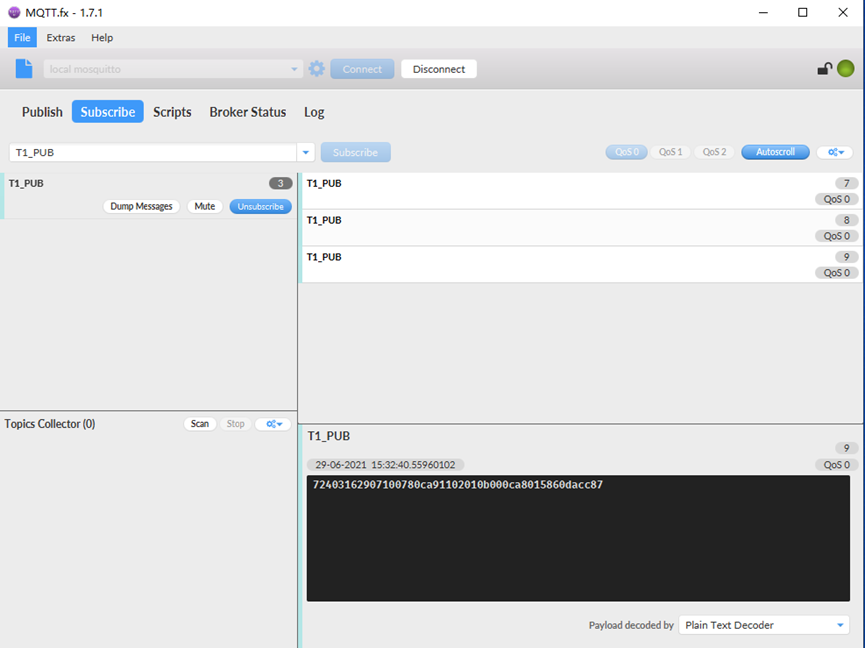
So the payload is 0xf868411056754138 0078 0ca9 11 02 010b 00 0ca8 0158 60dacc87
where:
- Device ID: 0xf868411056754138 = 868411056754138
- Version: 0x0078=120=1.2.0
- BAT: 0x0ca9 = 3241mV = 3.241 V
- Singal: 0x11 = 17
- Model: 0x02 = 2
- Temperature by DS18b20: 0x010b= 267 = 26.7 °C
- Interrupt: 0x00 = 0
- ADC: 0x0ca8 = 3240 mv
- Distance by LIDAR-Lite V3HP/Ultrasonic Sensor: 0x0158 = 344 cm
- Timestamp: 0x60dacc87 = 1,624,951,943 = 2021-06-29 15:32:23
Connection of LIDAR-Lite V3HP:
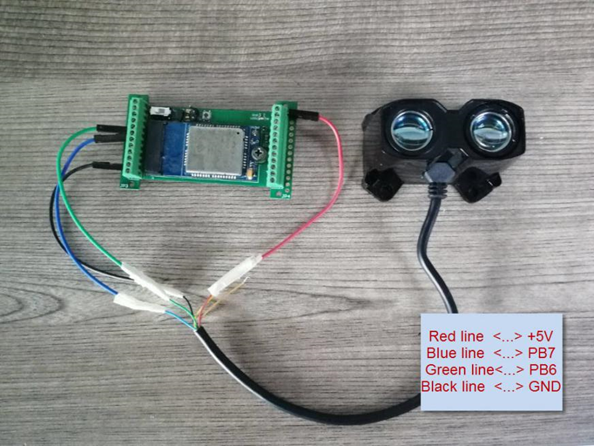
Connection to Ultrasonic Sensor:
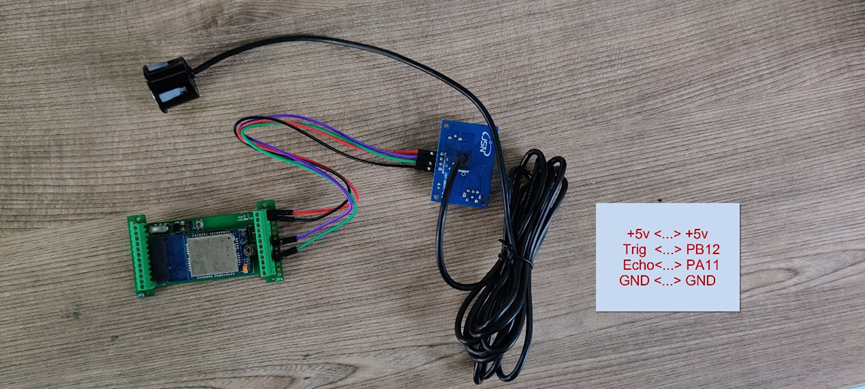
2.2.3 CFGMOD=3 (3 ADC + I2C)
This mode has total 29 bytes. Include 3 x ADC + 1x I2C, (Note: Time stamp field are added since firmware version v1.2.0)
Size(bytes) | 8 | 2 | 2 | 1 | 1 | 2 | 1 | 2 | 2 | 2 | 2 | 4 |
|---|---|---|---|---|---|---|---|---|---|---|---|---|
| Value | Device ID | Ver | BAT | Signal Strength | MOD 0x03 | ADC1 | Digital in & Interrupt | ADC2 | ADC3 | Timestamp |
ADC1 uses pin PA0 to measure
ADC2 uses pin PA1 to measure
ADC3 uses pin PA4 to measure
If the cache upload mechanism is turned on, you will receive the payload shown in the figure below.
| Frame header | Frame data(1) | Frame data(2) | F… | Frame data(X) |
NOTE:
1. Only up to 10 sets of latest data will be cached.
2. Theoretically, the maximum upload bytes are 226.
If we use the MQTT client to subscribe to this MQTT topic, we can see the following information when the NB sensor uplink data.

So the payload is 0x f868411056754138 0078 0cf0 12 03 0cbc 00 0cef 010a 024b 0cef 60dbc494
where:
- Device ID: 0xf868411056754138 = 868411056754138
- Version: 0x0078=120=1.2.0
- BAT: 0x0cf0 = 3312 mV = 3.312 V
- Singal: 0x12 = 18
- Model: 0x03 = 3
- ADC1: 0x0cbc= 3260mV
- Interrupt: 0x00 = 0
- ADC2: 0x0cef =3311 mv
- Temperature by SHT20/SHT31: 0x010a = 266 = 26.6 °C
- Humidity by SHT20/SHT31: 0x024b =587 = 58.7 %rh
- ADC3: 0x0cef = 3311 mv
- Timestamp: 0x60dbc494 = 1,625,015,444= 2021-06-30 09:10:44
2.2.4 CFGMOD=4 (3 x DS18B20)
Hardware connection is as below, (Note: R3 & R4 should change from 10k to 4.7k to support DS18B20, Software set to AT+CFGMOD=4)
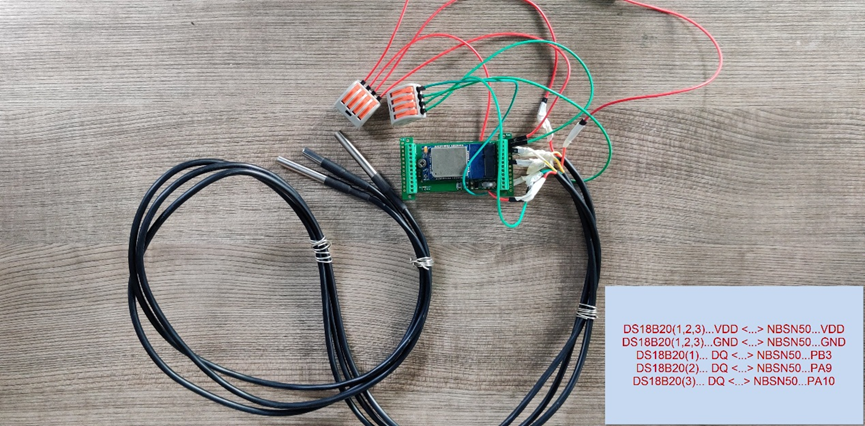
This mode has total 27 bytes. (Note: Time stamp field are added since firmware version v1.2.0) As shown below:
Size(bytes) | 8 | 2 | 2 | 1 | 1 | 2 | 2 | 1 | 2 | 2 | 4 |
|---|---|---|---|---|---|---|---|---|---|---|---|
| Value | Device ID | Ver | BAT | Signal Strength | MOD 0x04 | ADC | Digital in & Interrupt | Timestamp |
If the cache upload mechanism is turned on, you will receive the payload shown in the figure below.
| Frame header | Frame data(1) | Frame data(2) | F… | Frame data(X) |
NOTE:
1. Only up to 10 sets of latest data will be cached.
2. Theoretically, the maximum upload bytes is 215.
If we use the MQTT client to subscribe to this MQTT topic, we can see the following information when the NB sensor uplink data.
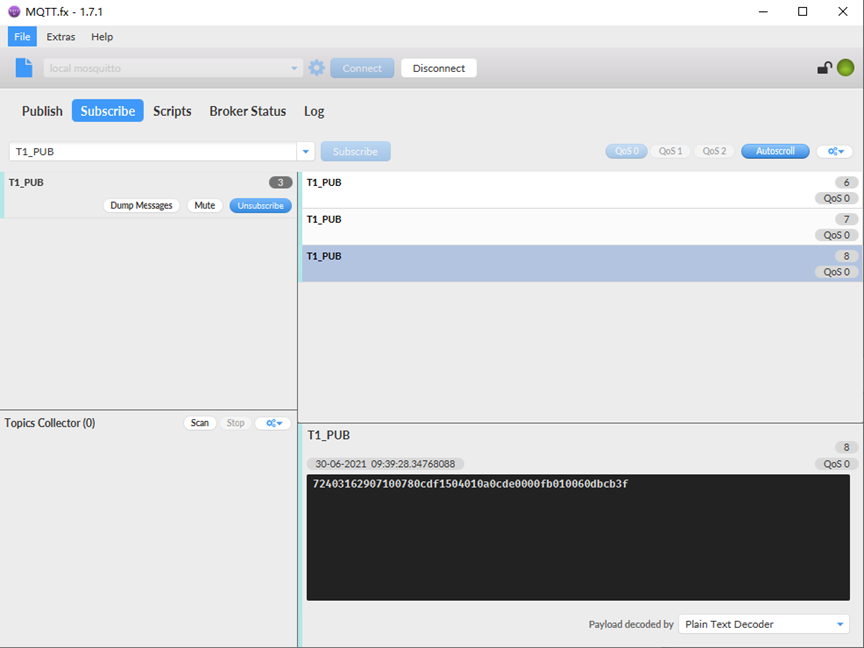
So the payload is 0x f868411056754138 0078 0cdf 15 04 010a 0cde 00 00fb 0100 60dbcb3f
where:
- Device ID: 0xf868411056754138 = 868411056754138
- Version: 0x0078=120=1.2.0
- BAT: 0x0cdf = 3295 mV = 3.295 V
- Singal: 0x15 = 21
- Model: 0x04 = 4
- Temperature1 by DS18b20: 0x010a = 226 = 22.6 °C
- ADC: 0x0cde = 3294 mv
- Interrupt: 0x00 = 0
- Temperature2 by DS18b20: 0x00fb = 251 = 25.1°C
- Temperature3 by DS18b20: 0x0100 = 256 = 25.6 °C
- Timestamp: 0x60dbcb3f = 1,625,017,151= 2021-06-30 09:39:11
2.2.5 CFGMOD=5 (Weight Measurement by HX711)
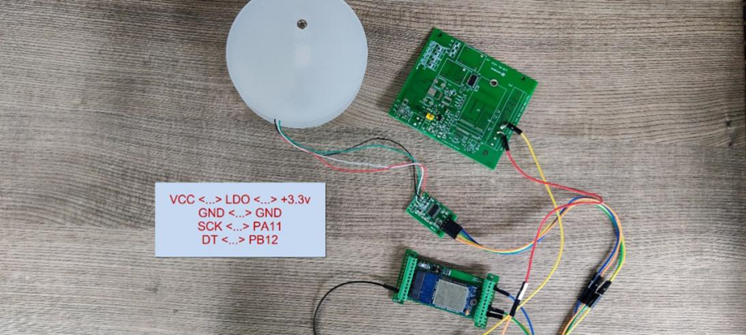
Notes about hardware connection:
- Don't connect the HX711 module VCC to SN50v3-NB 3.3v VCC, in this case, the SN50v3-NB will always power on HX711 and the battery will run out soon.
- HX711 support 5v VCC, but while connect the SN50v3-NB's +5V to HX711 VCC, the value from HX711 is not stable.
- Connect SN50v3-NB +5V to HX711 VCC via a LDO module is stable.
Each HX711 need to be calibrated before used. User need to do below two steps:
- Zero calibration. Don't put anything on load cell and run AT+WEIGRE to calibrate to Zero gram.
- Adjust calibration factor (default value 400): Put a known weight thing on load cell and run AT+WEIGAP to adjust the Calibration Factor.
For example:
AT+WEIGAP =403.0
Response: Weight is 401 g
Check the response of this command and adjust the value to match the real value for thing.
This mode has total 25 bytes. (Note: Time stamp field are added since firmware version v1.2.0). As shown below:
Size(bytes) | 8 | 2 | 2 | 1 | 1 | 2 | 2 | 1 | 2 | 4 |
|---|---|---|---|---|---|---|---|---|---|---|
| Value | Device ID | Ver | BAT | Signal Strength | MOD 0x05 | ADC | Digital in & Interrupt | Timestamp |
If the cache upload mechanism is turned on, you will receive the payload shown in the figure below.
| Frame header | Frame data(1) | Frame data(2) | F… | Frame data(X) |
NOTE:
1. Only up to 10 sets of latest data will be cached.
2. Theoretically, the maximum upload bytes are 193.
If we use the MQTT client to subscribe to this MQTT topic, we can see the following information when the NB sensor uplink data.
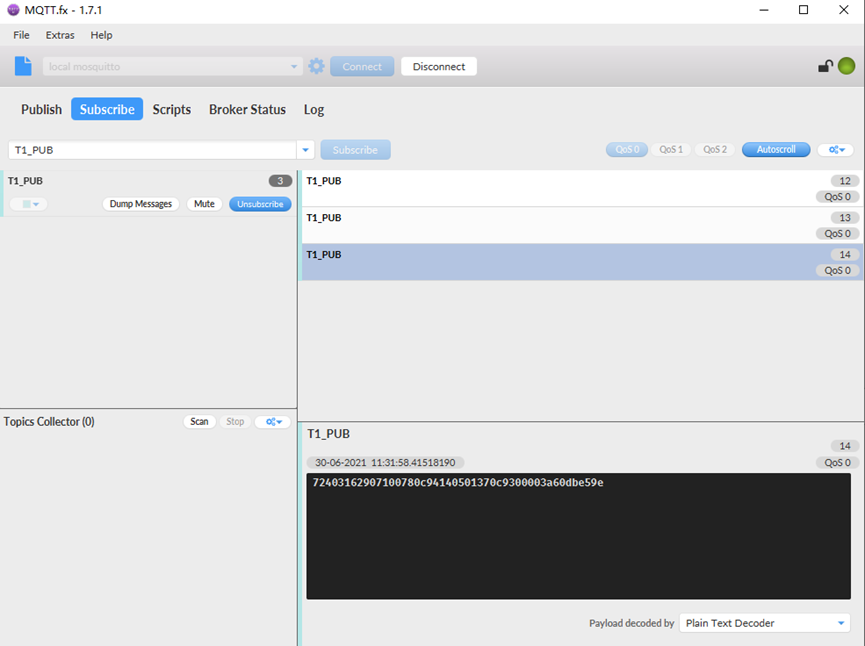
So the payload is 0x f868411056754138 0078 0c94 14 05 0137 0c93 00 003a 60dbe59e
where:
- Device ID: 0xf868411056754138 = 868411056754138
- Version: 0x0078=120=1.2.0
- BAT: 0x0c94 = 3220 mV = 3.220 V
- Singal: 0x14 = 20
- Model: 0x05 = 5
- Temperature by DS18b20: 0x0137 = 311 = 31.1 °C
- ADC: 0x0c93 = 3219 mv
- Interrupt: 0x00 = 0
- Weigt by HX711: 0x003a = 58 g
- Timestamp: 0x60dbe59e = 1,625,023,902= 2021-06-30 11:31:42
2.2.6 CFGMOD=6 (Counting mode)
In this mode, uplink payload includes in total 22 bytes, (Note: Time stamp field are added since firmware version v1.2.0)
Size(bytes) | 8 | 2 | 2 | 1 | 1 | 4 | 4 |
|---|---|---|---|---|---|---|---|
| Value | Device ID | Ver | BAT | Signal Strength | MOD 0x06 | Pulse count | Timestamp |
If the cache upload mechanism is turned on, you will receive the payload shown in the figure below.
| Frame header | Frame data(1) | Frame data(2) | F… | Frame data(X) |
NOTE:
1. Only up to 10 sets of latest data will be cached.
2. Theoretically, the maximum upload bytes are 160.
If we use the MQTT client to subscribe to this MQTT topic, we can see the following information when the NB sensor uplink data.
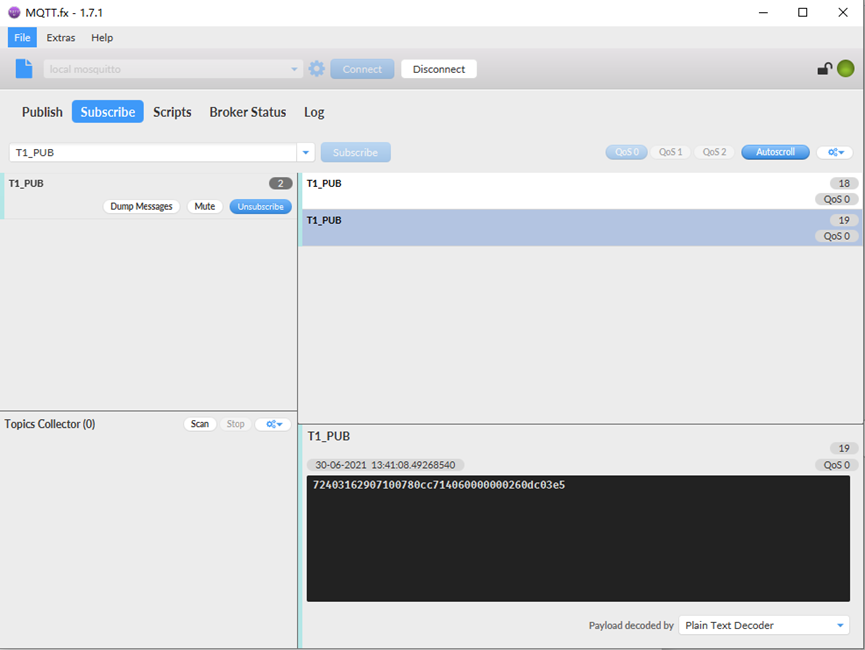
The payload is ASCII string, representative same HEX: 0x f868411056754138 0078 0cc7 14 06 00000002 60dc03e5
where:
- Device ID: 0xf868411056754138 = 868411056754138
- Version: 0x0078=120=1.2.0
- BAT: 0x0cc7 =3271mV =3.271V
- Singal: 0x14 = 20
- Model: 0x06 = 6
- Pulse count: 0x00000002= 2
- Timestamp: 0x60dc03e5 = 1,625,031,653= 2021-06-30 13:40:53
2.3 Payload Types
To meet different server requirement, SN50v3-NB supports different payload type.
Includes:
- General JSON format payload. (Type=5)
- HEX format Payload. (Type=0)
- ThingSpeak Format. (Type=1)
- ThingsBoard Format. (Type=3)
User can specify the payload type when choose the connection protocol. Example:
AT+PRO=2,0 // Use UDP Connection & hex Payload
AT+PRO=2,5 // Use UDP Connection & Json Payload
AT+PRO=3,5 // Use MQTT Connection & Json Payload
2.3.1 General Json Format(Type=5)
This is the General Json Format. As below:
{"IMEI":866207053462762,"temperature":29.2,"humidity":54.2,"battery":3.27,"signal":24,"Model":S31x-NB, "1":{28.2,48.3,2023/08/10 08:00:37},"2":{28.1,49.1,2023/08/10 07:57:37},"3":{28.1,48.5,2023/08/10 07:54:37},"4":{28.2,48.6,2023/08/10 07:51:37},"5":{28.1,48.9,2023/08/10 07:48:37},"6":{28.2,48.8,2023/08/10 07:45:37},"7":{28.2,48.8,2023/08/10 07:42:37},"8":{28.0,48.8,2023/08/10 07:39:37}}
Notice, from above payload:
- Temperature , Humidity , Battery & Signal are the value at uplink time.
- Json entry 1 ~ 8 are the last 1 ~ 8 sampling data as specify by AT+NOUD=8 Command. Each entry includes (from left to right): Temperature, Humidity, Sampling time.
2.3.2 HEX format Payload(Type=0)
This is the HEX Format. As below:
f86620705346276200640cba16010000000011011801e864d49c2d011a01e364d49925011901eb64d49871011901e564d497bd011a01e664d49709011901e964d49655011a01e864d495a1011a01e864d494ed011801e864d49439

Version:
These bytes include the hardware and software version.
Higher byte: Specify Sensor Model: 0x00 for SN50v3
Lower byte: Specify the software version: 0x64=100, means firmware version 1.0.0
BAT (Battery Info):
Ex1: 0x0CBA = 3258mV
Signal Strength:
NB-IoT Network signal Strength.
Ex1: 0x16 = 22
0 -113dBm or less
1 -111dBm
2...30 -109dBm... -53dBm
31 -51dBm or greater
99 Not known or not detectable
Temperature:
If payload is: 0105H: (0105 & 8000 == 0), temp = 0105H /10 = 26.1 degree
If payload is: FF3FH : (FF3F & 8000 == 1) , temp = (FF3FH - 65536)/10 = -19.3 degrees.
(FF3F & 8000: Judge whether the highest bit is 1, when the highest bit is 1, it is negative)
Humidity:
Read:0295(H)=661(D) Value: 661 / 10=66.1, So 66.1%
TimeStamp:
Unit TimeStamp Example: 64d49439(H) = 1691653177(D)
Put the decimal value into this link(https://www.epochconverter.com/) to get the time.
2.3.3 ThingsBoard Payload(Type=3)
Type3 payload special design for ThingsBoard, it will also configure other default server to ThingsBoard.
{"IMEI":866207053462762,"temperature":29.2,"humidity":54.2,"battery":3.27,"signal":24}
2.3.4 ThingSpeak Payload(Type=1)
This payload meets ThingSpeak platform requirement. It includes only four fields. Form 1~4 are:
Temperature, Humidity, Battery & Signal. This payload type only valid for ThingsSpeak Platform
As below:
field1=27.9&field2=49.9&field3=3.23&field4=28
2.4 Test Uplink and Change Update Interval
By default, Sensor will send uplinks every 2 hours & AT+NOUD=8
User can use below commands to change the uplink interval.
AT+TDC=600 // Set Update Interval to 600s
User can also push the button for more than 1 seconds to activate an uplink.
2.5 Multi-Samplings and One uplink
To save battery life, SN50v3-NB will sample temperature & humidity data every 15 minutes and send one uplink every 2 hours. So each uplink it will include 8 stored data + 1 real-time data. They are defined by:
- AT+TR=900 // The unit is seconds, and the default is to record data once every 900 seconds (15 minutes, the minimum can be set to 180 seconds)
- AT+NOUD=8 // The device uploads 8 sets of recorded data by default. Up to 32 sets of record data can be uploaded.
The diagram below explains the relationship between TR, NOUD, and TDC more clearly:
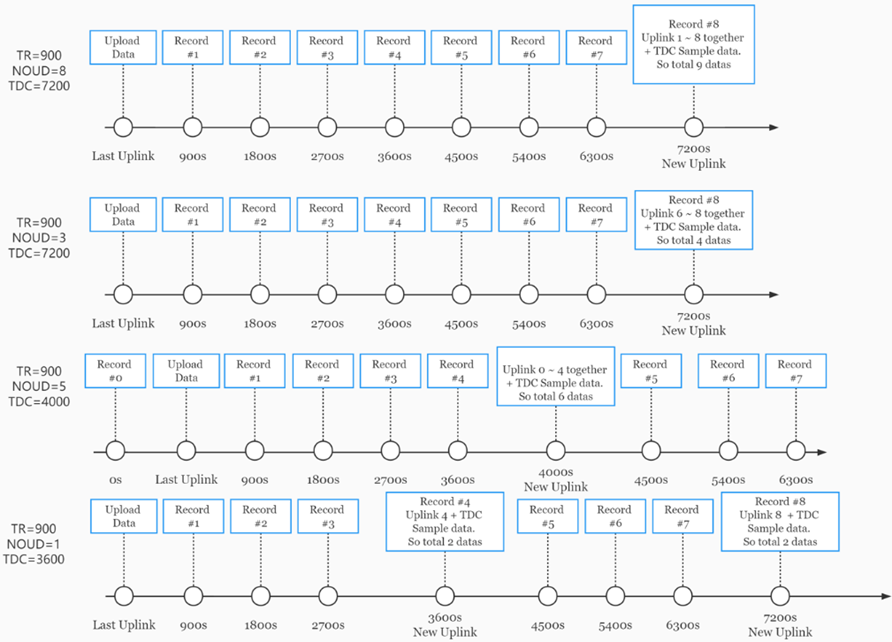
2.6 Trggier an uplink by external interrupt
SN50v3-NB has an external trigger interrupt function. Users can use the PB15 pin to trigger the upload of data packets.
AT command:
- AT+INTMOD // Set the trigger interrupt mode
- AT+INTMOD=0 // Disable Interrupt
- AT+INTMOD=1 // Trigger by rising and falling edge
- AT+INTMOD=2 // Trigger by falling edge
- AT+INTMOD=3 // Trigger by rising edge
3. Configure SN50v3-NB
3.1 Configure Methods
SN50v3-NB supports below configure method:
- AT Command via Bluetooth Connection (Recommended): BLE Configure Instruction.
- AT Command via UART Connection : See UART Connection.
3.2 AT Commands Set
AT+<CMD>? : Help on <CMD>
AT+<CMD> : Run <CMD>
AT+<CMD>=<value> : Set the value
AT+<CMD>=? : Get the value
General Commands
AT : Attention
AT? : Short Help
ATZ : MCU Reset
AT+TDC : Application Data Transmission Interval
AT+CFG : Print all configurations
AT+CFGMOD : Working mode selection
AT+DEUI : Get or set the Device ID
AT+INTMOD : Set the trigger interrupt mode
AT+5VT : Set extend the time of 5V power
AT+PRO : Choose agreement
AT+RXDL : Extend the sending and receiving time
AT+DNSCFG : Get or Set DNS Server
AT+GETSENSORVALUE : Returns the current sensor measurement
AT+NOUD : Get or Set the number of data to be uploaded
AT+CDP : Read or Clear cached data
AT+SHTEMP: Get or Set alarm of temp
AT+SHHUM: Get or Set alarm of moisture
AT+SERVADDR : Server Address
UDP Management
AT+CFM : Upload confirmation mode (only valid for UDP)
MQTT Management
AT+CLIENT : Get or Set MQTT client
AT+UNAME : Get or Set MQTT Username
AT+PWD : Get or Set MQTT password
AT+PUBTOPIC : Get or Set MQTT publish topic
AT+SUBTOPIC : Get or Set MQTT subscription topic
Information
AT+FDR : Factory Data Reset
AT+PWORD : Serial Access Password
AT+LDATA : Get the last upload data
AT+CDP : Read or Clear cached data
4. Battery & Power Consumption
SN50v3-NB use ER26500 + SPC1520 battery pack. See below link for detail information about the battery info and how to replace.
Battery Info & Power Consumption Analyze .
5. Firmware update
User can change device firmware to::
- Update with new features.
- Fix bugs.
Firmware and changelog can be downloaded from : Firmware download link
Methods to Update Firmware:
- (Recommended way) OTA firmware update via BLE: Instruction.
- Update through UART TTL interface : Instruction.
6. FAQ
6.1 How can I access t BC660K-GL AT Commands?
User can access to BC660K-GL directly and send AT Commands.
7. Order Info
Part Number: SN50v3-NB-XX
XX:
- GE: General version ( Exclude SIM card)
- 1D: with 1NCE* 10 years 500MB SIM card and Pre-configure to DataCake server
YY: The grand connector hole size
- M12: M12 hole
- M16: M16 hole
- M20: M20 hole
8. Packing Info
Package Includes:
- SN50v3-NB NB-IoT Sensor Node x 1
- External antenna x 1
Dimension and weight:
- Device Size: 13.0 x 5 x 4.5 cm
- Device Weight: 150g
- Package Size / pcs : 14.0 x 8x 5 cm
- Weight / pcs : 180g
9. Support
- Support is provided Monday to Friday, from 09:00 to 18:00 GMT+8. Due to different timezones we cannot offer live support. However, your questions will be answered as soon as possible in the before-mentioned schedule.
- Provide as much information as possible regarding your enquiry (product models, accurately describe your problem and steps to replicate it etc) and send a mail to Support@dragino.cc.



